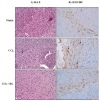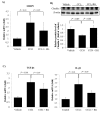Network Pharmacology-Based Approaches of Rheum undulatum Linne and Glycyrriza uralensis Fischer Imply their Regulation of Liver Failure with Hepatic Encephalopathy in Mice
- PMID: 32178308
- PMCID: PMC7175377
- DOI: 10.3390/biom10030437
Network Pharmacology-Based Approaches of Rheum undulatum Linne and Glycyrriza uralensis Fischer Imply their Regulation of Liver Failure with Hepatic Encephalopathy in Mice
Abstract
Rheum undulatum and Glycyrrhiza uralensis have been used as supplementary ingredients in various herbal medicines. They have been reported to have anti-inflammatory and antioxidant effects and, therefore, have potential in the treatment and prevention of various liver diseases. Considering that hepatic encephalopathy (HE) is often associated with chronic liver failure, we investigated whether an R. undulatum and G. uralensis extract mixture (RG) could reduce HE. We applied systems-based pharmacological tools to identify the active ingredients in RG and the pharmacological targets of RG by examining mechanism-of-action profiles. A CCl4-induced HE mouse model was used to investigate the therapeutic mechanisms of RG on HE. We successfully identified seven bioactive ingredients in RG with 40 potential targets. Based on an integrated target-disease network, RG was predicted to be effective in treating neurological diseases. In animal models, RG consistently relieved HE symptoms by protecting blood-brain barrier permeability via downregulation of matrix metalloproteinase-9 (MMP-9) and upregulation of claudin-5. In addition, RG inhibited mRNA expression levels of both interleukin (IL)-1β and transforming growth factor (TGF)-β1. Based on our results, RG is expected to function various biochemical processes involving neuroinflammation, suggesting that RG may be considered a therapeutic agent for treating not only chronic liver disease but also HE.
Keywords: Glycyrriza uralensis; MMP-9; Rheum undulatum; hepatic encephalopathy; neuroinflammation.
Conflict of interest statement
The authors declare no conflict of interest.
Figures









Similar articles
-
[Preventive and therapeutic effects of extract from Rheum palmatum on hepatic encephalopathy in rats with acute liver failure].Zhong Yao Cai. 2002 Aug;25(8):573-5. Zhong Yao Cai. 2002. PMID: 12599696 Chinese.
-
Elevated circulating TGFβ1 during acute liver failure activates TGFβR2 on cortical neurons and exacerbates neuroinflammation and hepatic encephalopathy in mice.J Neuroinflammation. 2019 Apr 2;16(1):69. doi: 10.1186/s12974-019-1455-y. J Neuroinflammation. 2019. PMID: 30940161 Free PMC article.
-
BabaoDan cures hepatic encephalopathy by decreasing ammonia levels and alleviating inflammation in rats.J Ethnopharmacol. 2020 Mar 1;249:112301. doi: 10.1016/j.jep.2019.112301. Epub 2019 Oct 14. J Ethnopharmacol. 2020. PMID: 31622746
-
The liver-brain axis in liver failure: neuroinflammation and encephalopathy.Nat Rev Gastroenterol Hepatol. 2013 Sep;10(9):522-8. doi: 10.1038/nrgastro.2013.99. Epub 2013 Jul 2. Nat Rev Gastroenterol Hepatol. 2013. PMID: 23817325 Review.
-
Neurosteroids in hepatic encephalopathy: Novel insights and new therapeutic opportunities.J Steroid Biochem Mol Biol. 2016 Jun;160:94-7. doi: 10.1016/j.jsbmb.2015.11.006. Epub 2015 Nov 14. J Steroid Biochem Mol Biol. 2016. PMID: 26589093 Review.
Cited by
-
Acute Liver Toxicity Modifies Protein Expression of Glutamate Transporters in Liver and Cerebellar Tissue.Front Neurosci. 2021 Jan 6;14:613225. doi: 10.3389/fnins.2020.613225. eCollection 2020. Front Neurosci. 2021. PMID: 33488353 Free PMC article.
-
An Ethnopharmaceutical Study on the Hypolipidemic Formulae in Taiwan Issued by Traditional Chinese Medicine Pharmacies.Front Pharmacol. 2022 Sep 15;13:900693. doi: 10.3389/fphar.2022.900693. eCollection 2022. Front Pharmacol. 2022. PMID: 36188612 Free PMC article.
-
Mitochondrial Changes in Rat Brain Endothelial Cells Associated with Hepatic Encephalopathy: Relation to the Blood-Brain Barrier Dysfunction.Neurochem Res. 2024 Jun;49(6):1489-1504. doi: 10.1007/s11064-022-03698-7. Epub 2022 Aug 2. Neurochem Res. 2024. PMID: 35917006 Free PMC article. Review.
-
Maillard and Hydrolytic Reactions in Subcritical Water Extraction of Bioactive Compounds from Licorice.Molecules. 2022 Oct 13;27(20):6851. doi: 10.3390/molecules27206851. Molecules. 2022. PMID: 36296445 Free PMC article.
-
Anti-inflammatory strategies for hepatic encephalopathy: preclinical studies.Arq Neuropsiquiatr. 2023 Jul;81(7):656-669. doi: 10.1055/s-0043-1767819. Epub 2023 Jul 24. Arq Neuropsiquiatr. 2023. PMID: 37487550 Free PMC article. Review.
References
-
- Vilstrup H., Amodio P., Bajaj J., Cordoba J., Ferenci P., Mullen K.D., Weissenborn K., Wong P. Hepatic encephalopathy in chronic liver disease: 2014 Practice Guideline by the American Association for the Study of Liver Diseases and the European Association for the Study of the Liver. Hepatology. 2014;60:715–735. doi: 10.1002/hep.27210. - DOI - PubMed
-
- Dadsetan S., Waagepetersen H.S., Schousboe A., Bak L.K. Glutamine and ammonia in hepatic encephalopathy. In: Rajendram R., Preedy V.R., Patel V.B., editors. Glutamine in Clinical Nutrition. Springer; Berlin/Heidelberg, Germany: 2015.
Publication types
MeSH terms
Substances
Grants and funding
LinkOut - more resources
Full Text Sources
Miscellaneous

